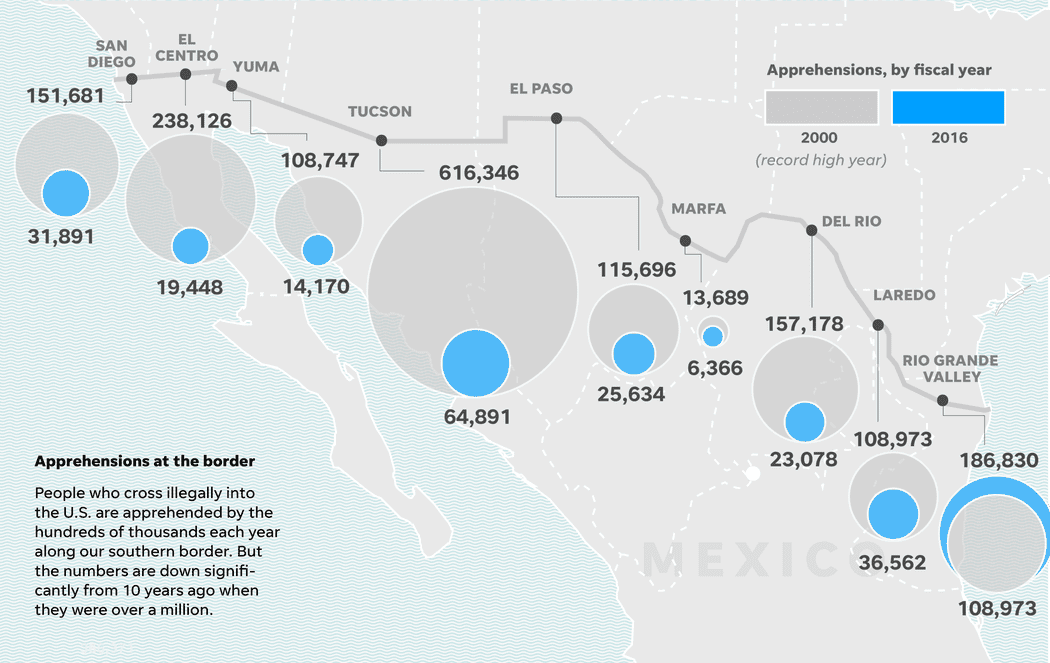Increased Border Security: Fewer Arrests, Higher Turnback Rates

Table of Contents
Recent years have witnessed a dramatic shift in global border security strategies. This has led to a complex and often paradoxical situation: increased border security measures are resulting in fewer arrests but simultaneously higher turnback rates. This article delves into this multifaceted issue, examining the effectiveness, ethical considerations, and economic impacts of this evolving approach to border control. We will analyze whether this shift represents a genuine success in deterring illegal immigration or masks deeper systemic problems.
The Shifting Landscape of Border Enforcement
The traditional approach to border security, heavily reliant on apprehension and arrest after illegal crossings, is rapidly changing. Modern strategies prioritize prevention and deterrence through a multi-pronged approach.
-
Technological Surveillance: Advanced technologies like drones, thermal imaging cameras, and sophisticated sensor networks provide real-time monitoring of border areas, enabling early detection of potential crossings. This proactive approach aims to prevent illegal entry before it occurs. Biometric identification systems further aid in identifying individuals and tracking movements.
-
Improved Border Infrastructure: Investments in physical barriers, such as fences and walls, coupled with improved road networks and patrol access, significantly enhance the ability to monitor and control border crossings. This includes upgrades to existing infrastructure and the construction of new border checkpoints.
-
Enhanced Intelligence Gathering: Increased cooperation with international partners and improved intelligence gathering capabilities allow for the disruption of smuggling networks and the identification of key players in human trafficking operations. This preemptive approach seeks to address the root causes of illegal migration.
-
International Cooperation: Successful border management increasingly relies on collaboration with neighboring countries. Bilateral and multilateral agreements facilitate the swift return of individuals intercepted at the border, enhancing the effectiveness of turnback strategies. This collaborative approach requires strong diplomatic relations and shared security interests.
Fewer Arrests: A Sign of Success or Systemic Issue?
The decline in arrests at certain borders is often touted as evidence of the success of heightened security measures. Proponents argue this demonstrates the effectiveness of deterrence strategies in discouraging illegal crossings.
-
Reduced Illegal Crossings: Statistical data, where available and reliable, may show a decrease in the number of successful illegal crossings. However, the accuracy and completeness of this data are crucial for accurate interpretation.
-
Lower Crime Rates in Border Regions: Some studies suggest a correlation between decreased illegal immigration and reduced crime rates in areas near borders. This connection, however, requires further investigation and nuanced analysis to establish causality.
Conversely, critics contend that lower arrest numbers may not reflect a true reduction in illegal crossings but instead indicate other issues.
-
Underreporting: Incomplete or inaccurate data collection may lead to underreporting of actual crossings. This could be due to limitations in surveillance technology, insufficient staffing, or intentional underreporting by authorities.
-
Displacement of Crossings: Increased border security in one area may simply push illegal crossings to less-protected areas. This displacement effect means the overall number of illegal entries may not decrease, but rather shift geographically.
Higher Turnback Rates: Ethical and Legal Considerations
The rising trend of turning back migrants and asylum seekers at the border raises profound ethical and legal questions. The practice has drawn significant criticism regarding its compatibility with international law and human rights.
-
International Human Rights Law: International conventions, such as the 1951 Refugee Convention and its 1967 Protocol, protect the rights of refugees and asylum seekers. The practice of summary turnbacks may violate the principle of non-refoulement, which prohibits returning individuals to a place where they face a risk of persecution.
-
National Immigration Policies: National immigration laws and policies vary widely. While some countries may legally allow for the return of individuals intercepted at the border, others may have stricter regulations and processes for determining admissibility.
-
Due Process Concerns: Turnback procedures often bypass the right to seek asylum and have one's claim fairly assessed. This denial of due process violates fundamental human rights and international norms.
The Economic Impact of Increased Border Security
Enhanced border security carries significant economic implications, both in terms of costs and potential benefits.
-
Infrastructure Investment: The cost of building and maintaining physical barriers, upgrading surveillance technologies, and improving infrastructure is substantial. These investments can strain public budgets and divert resources from other important sectors.
-
Technology Upgrades: The development and implementation of advanced surveillance systems, data analysis tools, and biometric identification technologies require significant financial investment.
-
Personnel Costs: Increased staffing levels for border patrol agents, immigration officers, and support personnel significantly increase operating costs.
Potential economic benefits include a reduced burden on social services, a potentially more regulated labor market, and potentially reduced crime rates (although this connection remains debated). However, these benefits need to be carefully weighed against the considerable financial investment required for enhanced border security.
Reassessing the Effectiveness of Increased Border Security: A Call to Action
The relationship between increased border security, fewer arrests, and higher turnback rates is complex and warrants careful consideration. While reducing illegal immigration is a valid objective, this goal must be balanced against the ethical and legal obligations to protect human rights. A balanced approach is crucial, combining effective border management with respect for human dignity. Further research is needed to assess the long-term effectiveness of current strategies and explore alternative approaches that address both security concerns and human rights. A more nuanced and humane approach to increased border security is urgently needed.

Featured Posts
-
 Saisonende Bundesliga Abstieg Fuer Bochum Und Holstein Kiel Leipzig Ohne Champions League
May 11, 2025
Saisonende Bundesliga Abstieg Fuer Bochum Und Holstein Kiel Leipzig Ohne Champions League
May 11, 2025 -
 Henry Cavills Wolverine A Fan Driven Casting Choice For Marvels World War Hulk
May 11, 2025
Henry Cavills Wolverine A Fan Driven Casting Choice For Marvels World War Hulk
May 11, 2025 -
 Payton Pritchards Impact A Pivotal Role In Celtics Game 1 Playoff Victory
May 11, 2025
Payton Pritchards Impact A Pivotal Role In Celtics Game 1 Playoff Victory
May 11, 2025 -
 Bctv Daily Dispatch Superman Daredevil Vs Bullseye And 1923 News
May 11, 2025
Bctv Daily Dispatch Superman Daredevil Vs Bullseye And 1923 News
May 11, 2025 -
 Revealed Prince Andrews Explosive Behaviour According To Palace Insiders
May 11, 2025
Revealed Prince Andrews Explosive Behaviour According To Palace Insiders
May 11, 2025
